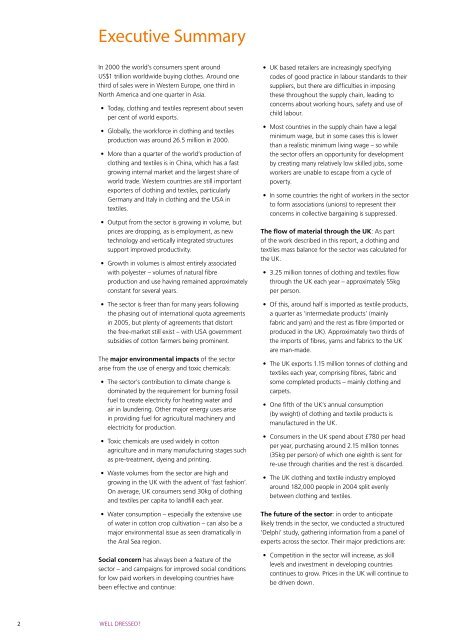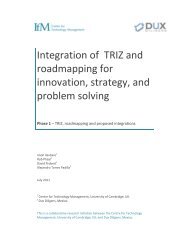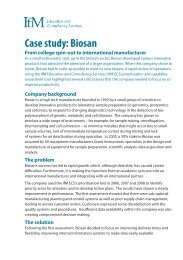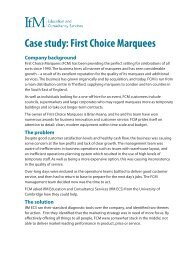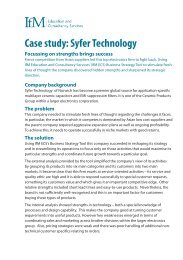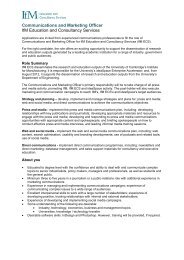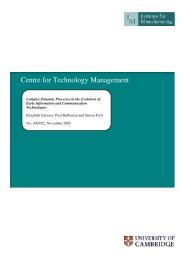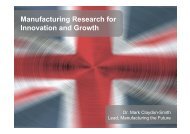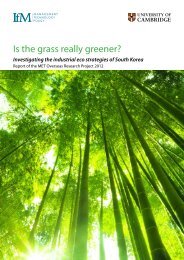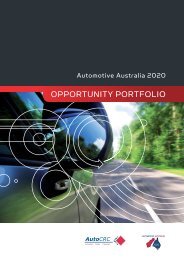The present and future sustainability of clothing and textiles in the ...
The present and future sustainability of clothing and textiles in the ...
The present and future sustainability of clothing and textiles in the ...
Create successful ePaper yourself
Turn your PDF publications into a flip-book with our unique Google optimized e-Paper software.
Executive Summary<br />
In 2000 <strong>the</strong> world’s consumers spent around<br />
US$1 trillion worldwide buy<strong>in</strong>g clo<strong>the</strong>s. Around one<br />
third <strong>of</strong> sales were <strong>in</strong> Western Europe, one third <strong>in</strong><br />
North America <strong>and</strong> one quarter <strong>in</strong> Asia.<br />
• Today, <strong>cloth<strong>in</strong>g</strong> <strong>and</strong> <strong>textiles</strong> re<strong>present</strong> about seven<br />
per cent <strong>of</strong> world exports.<br />
• Globally, <strong>the</strong> workforce <strong>in</strong> <strong>cloth<strong>in</strong>g</strong> <strong>and</strong> <strong>textiles</strong><br />
production was around 26.5 million <strong>in</strong> 2000.<br />
• More than a quarter <strong>of</strong> <strong>the</strong> world’s production <strong>of</strong><br />
<strong>cloth<strong>in</strong>g</strong> <strong>and</strong> <strong>textiles</strong> is <strong>in</strong> Ch<strong>in</strong>a, which has a fast<br />
grow<strong>in</strong>g <strong>in</strong>ternal market <strong>and</strong> <strong>the</strong> largest share <strong>of</strong><br />
world trade. Western countries are still important<br />
exporters <strong>of</strong> <strong>cloth<strong>in</strong>g</strong> <strong>and</strong> <strong>textiles</strong>, particularly<br />
Germany <strong>and</strong> Italy <strong>in</strong> <strong>cloth<strong>in</strong>g</strong> <strong>and</strong> <strong>the</strong> USA <strong>in</strong><br />
<strong>textiles</strong>.<br />
• Output from <strong>the</strong> sector is grow<strong>in</strong>g <strong>in</strong> volume, but<br />
prices are dropp<strong>in</strong>g, as is employment, as new<br />
technology <strong>and</strong> vertically <strong>in</strong>tegrated structures<br />
support improved productivity.<br />
• Growth <strong>in</strong> volumes is almost entirely associated<br />
with polyester – volumes <strong>of</strong> natural fibre<br />
production <strong>and</strong> use hav<strong>in</strong>g rema<strong>in</strong>ed approximately<br />
constant for several years.<br />
• <strong>The</strong> sector is freer than for many years follow<strong>in</strong>g<br />
<strong>the</strong> phas<strong>in</strong>g out <strong>of</strong> <strong>in</strong>ternational quota agreements<br />
<strong>in</strong> 2005, but plenty <strong>of</strong> agreements that distort<br />
<strong>the</strong> free-market still exist – with USA government<br />
subsidies <strong>of</strong> cotton farmers be<strong>in</strong>g prom<strong>in</strong>ent.<br />
<strong>The</strong> major environmental impacts <strong>of</strong> <strong>the</strong> sector<br />
arise from <strong>the</strong> use <strong>of</strong> energy <strong>and</strong> toxic chemicals:<br />
• <strong>The</strong> sector’s contribution to climate change is<br />
dom<strong>in</strong>ated by <strong>the</strong> requirement for burn<strong>in</strong>g fossil<br />
fuel to create electricity for heat<strong>in</strong>g water <strong>and</strong><br />
air <strong>in</strong> launder<strong>in</strong>g. O<strong>the</strong>r major energy uses arise<br />
<strong>in</strong> provid<strong>in</strong>g fuel for agricultural mach<strong>in</strong>ery <strong>and</strong><br />
electricity for production.<br />
• Toxic chemicals are used widely <strong>in</strong> cotton<br />
agriculture <strong>and</strong> <strong>in</strong> many manufactur<strong>in</strong>g stages such<br />
as pre-treatment, dye<strong>in</strong>g <strong>and</strong> pr<strong>in</strong>t<strong>in</strong>g.<br />
• Waste volumes from <strong>the</strong> sector are high <strong>and</strong><br />
grow<strong>in</strong>g <strong>in</strong> <strong>the</strong> UK with <strong>the</strong> advent <strong>of</strong> ‘fast fashion’.<br />
On average, UK consumers send 30kg <strong>of</strong> <strong>cloth<strong>in</strong>g</strong><br />
<strong>and</strong> <strong>textiles</strong> per capita to l<strong>and</strong>fill each year.<br />
• Water consumption – especially <strong>the</strong> extensive use<br />
<strong>of</strong> water <strong>in</strong> cotton crop cultivation – can also be a<br />
major environmental issue as seen dramatically <strong>in</strong><br />
<strong>the</strong> Aral Sea region.<br />
Social concern has always been a feature <strong>of</strong> <strong>the</strong><br />
sector – <strong>and</strong> campaigns for improved social conditions<br />
for low paid workers <strong>in</strong> develop<strong>in</strong>g countries have<br />
been effective <strong>and</strong> cont<strong>in</strong>ue:<br />
• UK based retailers are <strong>in</strong>creas<strong>in</strong>gly specify<strong>in</strong>g<br />
codes <strong>of</strong> good practice <strong>in</strong> labour st<strong>and</strong>ards to <strong>the</strong>ir<br />
suppliers, but <strong>the</strong>re are difficulties <strong>in</strong> impos<strong>in</strong>g<br />
<strong>the</strong>se throughout <strong>the</strong> supply cha<strong>in</strong>, lead<strong>in</strong>g to<br />
concerns about work<strong>in</strong>g hours, safety <strong>and</strong> use <strong>of</strong><br />
child labour.<br />
• Most countries <strong>in</strong> <strong>the</strong> supply cha<strong>in</strong> have a legal<br />
m<strong>in</strong>imum wage, but <strong>in</strong> some cases this is lower<br />
than a realistic m<strong>in</strong>imum liv<strong>in</strong>g wage – so while<br />
<strong>the</strong> sector <strong>of</strong>fers an opportunity for development<br />
by creat<strong>in</strong>g many relatively low skilled jobs, some<br />
workers are unable to escape from a cycle <strong>of</strong><br />
poverty.<br />
• In some countries <strong>the</strong> right <strong>of</strong> workers <strong>in</strong> <strong>the</strong> sector<br />
to form associations (unions) to re<strong>present</strong> <strong>the</strong>ir<br />
concerns <strong>in</strong> collective barga<strong>in</strong><strong>in</strong>g is suppressed.<br />
<strong>The</strong> flow <strong>of</strong> material through <strong>the</strong> UK: As part<br />
<strong>of</strong> <strong>the</strong> work described <strong>in</strong> this report, a <strong>cloth<strong>in</strong>g</strong> <strong>and</strong><br />
<strong>textiles</strong> mass balance for <strong>the</strong> sector was calculated for<br />
<strong>the</strong> UK.<br />
• 3.25 million tonnes <strong>of</strong> <strong>cloth<strong>in</strong>g</strong> <strong>and</strong> <strong>textiles</strong> flow<br />
through <strong>the</strong> UK each year – approximately 55kg<br />
per person.<br />
• Of this, around half is imported as textile products,<br />
a quarter as ‘<strong>in</strong>termediate products’ (ma<strong>in</strong>ly<br />
fabric <strong>and</strong> yarn) <strong>and</strong> <strong>the</strong> rest as fibre (imported or<br />
produced <strong>in</strong> <strong>the</strong> UK). Approximately two thirds <strong>of</strong><br />
<strong>the</strong> imports <strong>of</strong> fibres, yarns <strong>and</strong> fabrics to <strong>the</strong> UK<br />
are man-made.<br />
• <strong>The</strong> UK exports 1.15 million tonnes <strong>of</strong> <strong>cloth<strong>in</strong>g</strong> <strong>and</strong><br />
<strong>textiles</strong> each year, compris<strong>in</strong>g fibres, fabric <strong>and</strong><br />
some completed products – ma<strong>in</strong>ly <strong>cloth<strong>in</strong>g</strong> <strong>and</strong><br />
carpets.<br />
• One fifth <strong>of</strong> <strong>the</strong> UK’s annual consumption<br />
(by weight) <strong>of</strong> <strong>cloth<strong>in</strong>g</strong> <strong>and</strong> textile products is<br />
manufactured <strong>in</strong> <strong>the</strong> UK.<br />
• Consumers <strong>in</strong> <strong>the</strong> UK spend about £780 per head<br />
per year, purchas<strong>in</strong>g around 2.15 million tonnes<br />
(35kg per person) <strong>of</strong> which one eighth is sent for<br />
re-use through charities <strong>and</strong> <strong>the</strong> rest is discarded.<br />
• <strong>The</strong> UK <strong>cloth<strong>in</strong>g</strong> <strong>and</strong> textile <strong>in</strong>dustry employed<br />
around 182,000 people <strong>in</strong> 2004 split evenly<br />
between <strong>cloth<strong>in</strong>g</strong> <strong>and</strong> <strong>textiles</strong>.<br />
<strong>The</strong> <strong>future</strong> <strong>of</strong> <strong>the</strong> sector: <strong>in</strong> order to anticipate<br />
likely trends <strong>in</strong> <strong>the</strong> sector, we conducted a structured<br />
‘Delphi’ study, ga<strong>the</strong>r<strong>in</strong>g <strong>in</strong>formation from a panel <strong>of</strong><br />
experts across <strong>the</strong> sector. <strong>The</strong>ir major predictions are:<br />
• Competition <strong>in</strong> <strong>the</strong> sector will <strong>in</strong>crease, as skill<br />
levels <strong>and</strong> <strong>in</strong>vestment <strong>in</strong> develop<strong>in</strong>g countries<br />
cont<strong>in</strong>ues to grow. Prices <strong>in</strong> <strong>the</strong> UK will cont<strong>in</strong>ue to<br />
be driven down.<br />
<br />
WELL DRESSED?


